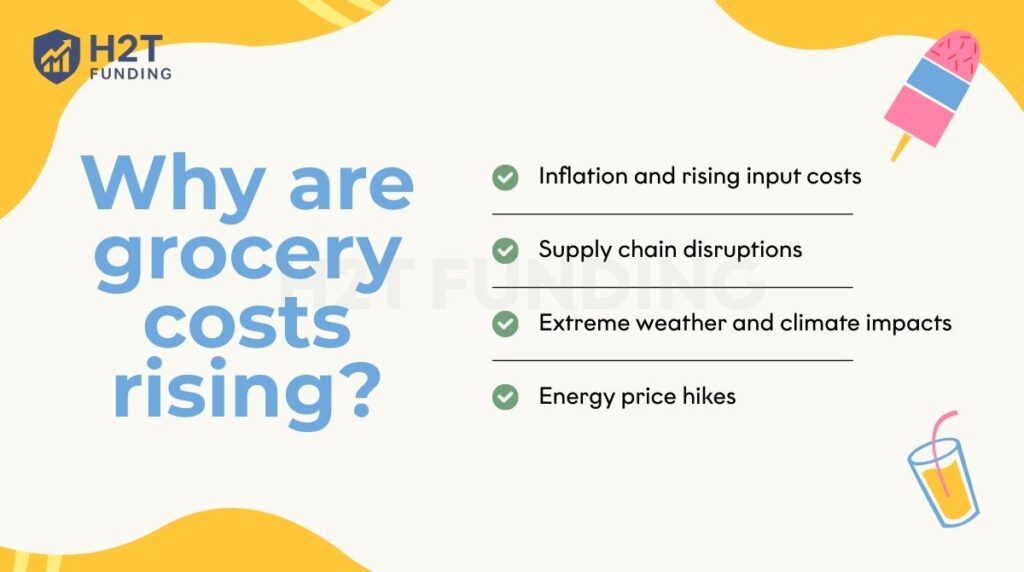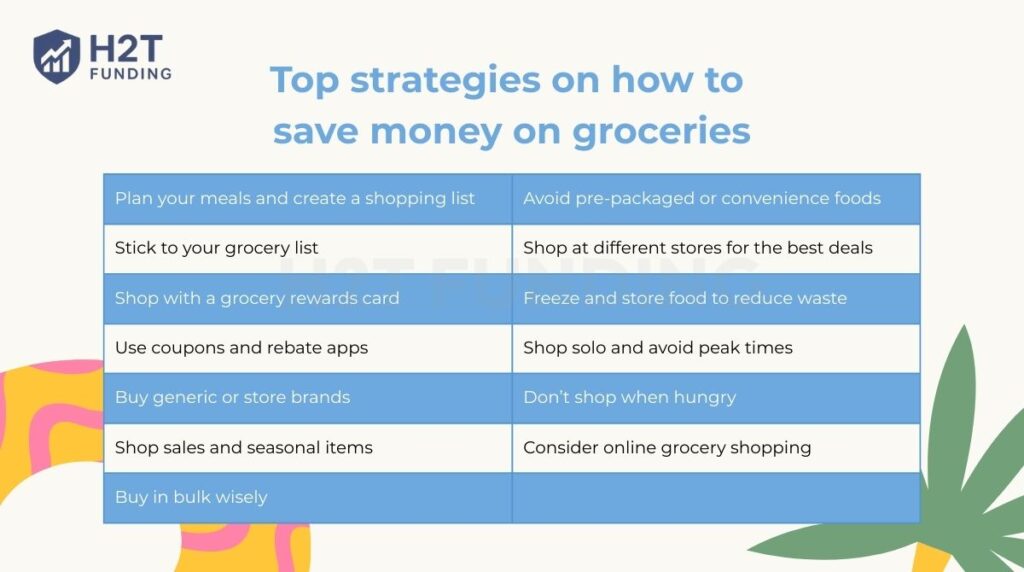Grocery costs can drain your budget before you know it. I realized we were spending over $600 a month on food for just two people, well above the norm. According to USDA data, a moderate grocery plan for two adults in 2024 is about $910 per month, but overspending often happens because of impulse buys, poor planning, and food waste.
That’s why these 13 budget-saving hacks on how to save money on groceries are your roadmap to smarter spending. At H2T Funding, we’ll show you practical ways how to save money for groceries, cut waste, and still enjoy healthy, tasty meals, helping you stretch every dollar further without stress.
Key takeaways
- Grocery costs keep rising due to inflation, supply chain issues, and climate impacts, making budgeting more important than ever.
- Meal planning, shopping with a list, and avoiding impulse buys can cut grocery costs by 10–25%.
- Large families benefit from bulk buying and meal prep, while individuals save more by focusing on smaller portions and reducing waste.
- A realistic grocery budget ranges from 10–15% of income, with USDA data guiding targets for singles, couples, and families.
1. Why are grocery costs rising?
Grocery prices have surged significantly in recent years, impacting household budgets worldwide. Understanding the reasons behind these increases helps shoppers adopt smart strategies to manage costs effectively. Below are the key factors driving higher grocery prices, along with why strategic shopping is essential for stretching your budget.

For those wondering how to save money on groceries in Canada, many of these strategies apply across borders despite regional price differences.
- Inflation and rising input costs: Inflation has driven up costs for agricultural inputs like fertilizer, fuel, and labor, increasing food production expenses. Since 2019, food prices in the U.S. have risen 31%, outpacing general inflation at 19%. These costs are often passed to consumers, making groceries pricier.
- Supply chain disruptions: Global events like the COVID-19 pandemic and the Russia-Ukraine war have disrupted supply chains, causing shortages of goods like wheat and oil. Port delays and transportation bottlenecks further raise costs.
- Extreme weather and climate impacts: Droughts, floods, and heat waves have reduced crop yields. This is especially true for fruits, vegetables, and grains. A U.S. drought in 2022 cut yields sharply, while erratic monsoons in India spiked prices for sugar and produce. Choosing frozen or seasonal produce can reduce costs while maintaining quality.
- Energy price hikes: Higher fuel costs increase transportation and production expenses, impacting food prices. For instance, diesel prices rose from $3.06/gallon in 2019 to $3.55 in 2024.
By understanding these factors, shoppers can learn how to save money on groceries, such as by meal planning, using rebate apps, or shopping at discount stores to control costs.
Smart shopping and learning how to prioritize expenses empower consumers to navigate rising prices while maintaining a balanced diet and budget. It is also a valuable tip on how to save money on groceries before you even step into a store.
2. 13 Top strategies: How to save money on groceries
Looking for how to save money on groceries without sacrificing quality or variety? You’re not alone. With rising food prices impacting households everywhere, finding practical ways to cut grocery costs has become essential.
In this section, I will explore 13 top practical strategies to save money on groceries, tips you can put to work this week.
- Plan your meals and create a shopping list
- Stick to your grocery list
- Shop with a grocery rewards card
- Use coupons and rebate apps
- Buy generic or store brands
- Shop sales and seasonal items
- Buy in bulk wisely
- Avoid pre-packaged or convenience foods
- Shop at different stores for the best deals
- Freeze and store food to reduce waste
- Shop solo and avoid peak times
- Don’t shop when hungry
- Consider online grocery shopping

Keep reading to see how each of these strategies works in practice and pick the ones that best fit your lifestyle.
2.1. Plan your meals and create a shopping list
If there’s one habit that forms the foundation of budget-friendly shopping, it’s meal planning. A well-crafted list ensures you purchase only what you need for the week. Checking your pantry first maximizes savings by using what you already have.
- Benefits of meal planning: Planning meals cuts impulse purchases by up to 23%, and is often the best way to save money on grocery shopping without changing what you eat. It helps you focus on recipes using affordable, in-season ingredients. Weekly menus prevent reliance on expensive takeout. Apps like Mealime simplify the process.
- Creating a detailed grocery List: Build your list around weekly recipes, prioritizing sale items and staples. Group items by store aisle for efficiency and include exact quantities. Use apps like AnyList to stay organized and avoid overbuying. Share lists with family for coordination; this simple habit is a proven answer to how to save on groceries week after week.
- Review pantry inventory: Check your pantry, fridge, and freezer before shopping to avoid duplicates. Use existing ingredients to inspire meals, reducing unnecessary purchases. Apps like Supercook generate recipes based on current stock. This step saves time and money.
2.2. Stick to your grocery list
Discipline is key to avoiding unplanned purchases that inflate your grocery bill. Retailers design stores to tempt you with extras, but a list keeps you focused. Use simple tactics to stay on track and shop within your budget.
- Importance of discipline: Sticking to a list prevents grabbing costly items like snacks or pre-packaged foods. It ensures you stay within your budget, saving 10-15% per trip, one of the most underrated tips on how to save money on groceries. Retailers place pricier items at eye level to lure you. A list helps you resist these tactics.
- Tips for staying focused: Set a budget before shopping and use cash to limit spending. Avoid aisles with non-essential items like candy or gadgets. Shop during quieter hours to reduce distractions. Apps like Out of Milk can send reminders to stick to your list.
Learning how to control spending habits through ways to stop overspending will also strengthen your discipline.
2.3. Shop with a grocery rewards card
Don’t leave free money on the table; if you’ve asked how do you save money on groceries without changing your menu, rewards cards are a fast start. They provide instant discounts or rewards for future use, but choosing the right card matters. Weigh the benefits against potential drawbacks to maximize value.
- How rewards cards work: Cards like the Blue Cash Preferred® Card offer up to 6% cashback on groceries (up to $6,000/year). Store-specific cards provide discounts or fuel points at chains like Kroger. Rewards accumulate for statement credits or gift cards. Always pay off balances to avoid interest.
- Popular cards: The Citi Double Cash® Card gives 2% cashback (1% on purchase, 1% on payment). Walmart and Target often match competitors’ prices; skip the convenience store for staples since markups are higher. Remember, comparing cards and using tools like budgeting apps can help you match rewards with your shopping habits and systematize how to save money on grocery shopping.
- Pros and cons: Pros include cashback, discounts, and fuel rewards; cons include annual fees or high interest if unpaid. Pay balances monthly to avoid negating savings. Be cautious of overspending to chase rewards. Choose cards with rewards that align with your grocery budget.
2.4. Use coupons and rebate apps
Coupons and rebate apps give instant or post-purchase savings. Digital tools make it easier than ever to find and use them. Combine with sales for maximum impact, exactly how to save money on food shopping when prices keep climbing. Many shoppers consider this the best way to save money on groceries app strategy.
- Finding and using coupons: Digital coupons on store apps (Kroger, Safeway) apply at checkout; check the sales flyer before you build your list. Websites such as Coupons.com provide printable or digital options. Sunday mailers still deliver traditional coupons. Always match coupons with items you truly need. If you wonder how to save money on groceries with coupons, start small and focus on essentials.
- Recommended rebate apps: Ibotta offers cashback on groceries after uploading receipts, with $10-20 monthly savings. Fetch Rewards gives points for any receipt, redeemable for gift cards. Rakuten provides cashback for online grocery purchases. Download multiple apps for flexibility.
- Combining coupons with sales: Stack digital coupons with store sales for up to 50% savings on select items. Check apps like Flipp for weekly deals to plan purchases. Avoid buying items just for rebates. Focus on essentials to ensure true savings.
For more practical strategies, explore this list of save money challenge ideas that can be applied alongside couponing to stretch your budget even further.
2.5. Buy generic or store brands
Generic brands offer significant savings without sacrificing quality, often costing 20-40% less than name brands. They’re ideal for staples and everyday items, especially homemade staples like soups, sauces, and baking mixes. Testing them ensures you find reliable options for your household.
- Cost savings: Generic brands save 20-40% on items like canned goods, pasta, or spices. For example, store-brand cereal can cost $2 less per box than name brands. Quality is often comparable, as many are made in the same facilities. Savings add up over time.
- Addressing quality concerns: Start with low-risk items like salt or flour to test quality. Read labels to compare ingredients with name brands. If unsatisfied, mix generics with trusted brands for balance. Most retailers offer money-back guarantees for store brands.
- Examples of generic items: Opt for store-brand canned vegetables, rice, or baking essentials. Chains like Aldi or Costco offer reliable generics like Kirkland Signature products. Try generics for snacks or cleaning supplies. Experiment to find your favorites.
For better long-term results, avoid common budgeting mistakes that can undermine your savings.
2.6. Shop sales and seasonal items
Timing your shopping around sales and seasonal produce can slash your grocery bill. In-season items are cheaper and fresher, while sales offer deep discounts. Tracking store promotions ensures you maximize savings.
- Shop on sale days: Visit stores on new sales days (often Wednesdays or Thursdays) to catch deals before items sell out. Check weekly flyers or apps like Flipp for discounts. Stock up on non-perishables during major sales. Plan meals around discounted items.
- Benefits of seasonal produce: In-season fruits and vegetables, like summer tomatoes or fall apples, cost less due to local abundance. They’re fresher, tastier, and eco-friendly with lower transport costs. Buy extras for freezing to save year-round. Use seasonal guides for planning.
- Track sales cycles: Monitor store sales patterns (e.g., monthly meat discounts) using apps like Grocery King. Sign up for store newsletters for deal alerts. Visit farmers’ markets late in the day for discounted produce. Compare prices across local stores.
2.7. Buy in bulk wisely
Bulk buying can lower per-unit costs but risks waste if not planned carefully. It’s ideal for staples and large households with storage space. Checking unit prices ensures true savings.
- Pros and cons: Bulk purchases save 20-25% on items like rice or canned goods, but require upfront costs and storage. Overbuying perishables leads to waste, negating savings. It’s best for non-perishables or freezeable items. Avoid bulk if cash flow is tight.
- Recommended items: Buy staples like pasta, beans, or toilet paper in bulk at warehouse clubs like Costco. Split purchases with friends to manage quantities. Ensure you’ll use items before they expire. Bulk spices are often cheaper than small jars.
- Check unit prices: Compare unit prices (e.g., price per ounce) on shelf tags to confirm savings. Larger packages aren’t always cheaper; smaller ones may be on sale. Use a calculator app for quick comparisons. Avoid bulk buys for short-shelf-life items.
Smarter planning with bulk buying works best when paired with strategies on how to save for a big purchase.
2.8. Avoid pre-packaged or convenience foods
Pre-packaged foods like chopped vegetables or meal kits inflate costs significantly. Preparing meals from scratch saves money and reduces waste. Simple recipes make this approach accessible.
- Higher costs: Pre-cut produce or meal kits can cost 2-3 times more than whole ingredients. For example, a 400g bag of carrot batons costs 79p vs. 33p for 500g whole carrots. Packaging adds to expenses and waste. Cooking at home is cheaper.
- Prepare from scratch: Buy whole vegetables, fruits, or bulk grains to save up to $100 monthly. Invest in tools like a food chopper to save time. Batch-prep ingredients for quick meals. Store leftovers properly to avoid spoilage. Using structured approaches like the zero-based budgeting method helps you plan these savings more effectively.
- Budget-friendly recipes: Try one-pot chili (beans, tomatoes, ground beef) or vegetable stir-fry with rice. Use pantry staples like lentils or pasta for affordable casseroles. Online recipes from Budget Bytes offer cheap, tasty ideas. Prep in bulk for efficiency.
2.9. Shop at different stores for the best deals
Comparing prices across stores helps you snag the lowest costs for your groceries. Discount stores and online tools make it easier to save. Exploring multiple options maximizes value.
- Compare store prices: Check prices at supermarkets, Aldi, Lidl, or farmers’ markets for savings. Walmart and Target often match competitors’ prices if you show proof. Learning how to save money on groceries at Walmart by combining price matching with cashback apps can lead to even bigger savings. Visit discount stores for staples like bread or canned goods.
- Plan routes to save gas: Following basic how-to save money on gas tips, like combining errands or carpooling, can further enhance your overall savings.
- Use online tools: Apps like Flipp or Basket compare prices across local stores in real-time. Check store websites for digital coupons or weekly deals. Join loyalty programs for exclusive discounts. Price tracking saves 10-15% on frequent purchases.
- Benefits of discount stores: Aldi and Lidl offer up to 30% lower prices on generics and produce. Their streamlined inventory reduces costs without sacrificing quality. Farmers’ markets provide fresh, local deals late in the day. Combine stores for optimal savings.
2.10. Freeze and store food to reduce waste
Freezing leftovers and bulk items extends shelf life, cutting waste and costs. Proper storage keeps food fresh and usable. Batch cooking saves time and money.
- Save with freezing: Freezing sale-priced meat, produce, or leftovers saves $1,500 annually for a family of four. Buy seasonal berries or meat in bulk and freeze them for later. Use freezer bags to portion items. Reduce trips to the store.
- Proper storage tips: Store food in airtight containers or vacuum-sealed bags to prevent freezer burn. Label items with dates to track freshness. Keep freezers at 0°F and fridges at 40°F. Use the USDA’s FoodKeeper app for storage guidelines. Smart storage also frees up money that can be redirected to priorities such as an emergency fund.
- Batch cooking: Prepare large batches of soups, casseroles, or sauces and freeze in portions. Reheat for quick, cheap meals during busy weeks.
2.11. Shop solo and avoid peak times
Shopping alone and during quieter hours minimizes distractions and impulse buys. A calm store environment allows for thoughtful decision-making, keeping your budget on track. This approach helps you stick to your list and avoid costly detours.
- Reducing impulse buys: Shopping solo prevents family members or kids from adding unplanned items like snacks to your cart. It helps you stay focused on your list, saving up to 15% per trip. Discuss needs with family beforehand to include their requests. This keeps everyone happy without extra costs.
- Off-Peak shopping: Shop early mornings or late evenings (e.g., after 8 p.m.) when stores are less crowded, like Tuesday evenings. A relaxed pace lets you compare prices and avoid rushed choices. Check store hours to find the quietest times. Less crowding means better focus.
- Calm environment benefits: A quieter store reduces stress, helping you make deliberate choices. You’re less likely to grab eye-level, pricier items in a rush. Take time to check unit prices or deals. A calm setting can cut impulse spending by 10%.
2.12. Don’t shop when hungry
Hunger can derail your budget by triggering cravings for expensive snacks. Eating before shopping keeps you focused on your list and financial goals. Simple discipline tactics ensure you avoid budget-busting impulse buys.
- Hunger and Impulse Purchases: Hunger increases impulse buys by up to 20%, as you’re drawn to high-calorie snacks or convenience foods. A 2018 study showed hungry shoppers prioritize cravings over nutrition. Eating a meal beforehand reduces this urge. Your wallet and diet benefit.
- Pre-Shopping Snack or Meal: Eat a protein-rich snack like yogurt or nuts before shopping to stabilize blood sugar. A full stomach curbs cravings for items like chips or candy. Plan shopping after meals, like post-breakfast. This keeps decision-making rational.
- Discipline Tips: Stick to a list and avoid snack aisles to minimize temptation. Set a timer for quick trips to stay focused. Use cash to limit spending to your budget. If tempted, wait until the next trip to reconsider purchases.
2.13. Consider online grocery shopping
Online shopping streamlines price comparisons and reduces in-store distractions. It offers exclusive deals and curbside pickup options to save time and money. Reviewing orders before checkout ensures you only buy essentials.
- Benefits of online shopping: Online platforms let you compare prices across brands easily, saving 10-15% on average. Fewer distractions reduce impulse buys compared to in-store shopping. Real-time cart totals help you stick to budgets. You can shop at your own pace.
- Online-exclusive deals: Services like Walmart or Kroger offer digital coupons and free pickup on minimum orders. First-time customer discounts can save $10-40 per order. Check platforms like Amazon Fresh for bulk deals. Always verify deals before adding items.
- Review orders before checkout: Double-check your online cart to remove unnecessary items, like suggested add-ons. Use stored lists to reorder staples, avoiding duplicates. Pause before confirming to ensure alignment with your meal plan. This step prevents overspending.
You can also explore communities like how to save money on groceries on Reddit to find real-life tips from experienced shoppers. The best way to save money on grocery shopping is to combine two or three that fit your routine.
3. Additional tips for specific audiences
Different households have unique grocery needs, but smart strategies can help everyone save. Whether you’re feeding a large family, shopping for one, or buying online, these tips are tailored to cut costs effectively. Apply them to stretch your budget while enjoying nutritious meals.

3.1. Saving for large families
Large families face higher grocery bills, but strategic planning can keep costs down. Meal planning and bulk buying are key to feeding many without breaking the bank. Cost-effective recipes make it easier to satisfy everyone.
- Meal planning for large households: Plan weekly menus around sales and pantry staples to save 20-30% on groceries. Use apps like eMeals to create budget-friendly family meals. Involve family members to ensure everyone’s preferences are met. Double recipes for leftovers to reduce cooking time.
- Bulk buying tips: Buy non-perishables like rice, beans, or pasta in bulk at Costco or Sam’s Club for 15-25% savings. Freeze extra meat or produce from sales to avoid waste. Split bulk purchases with another family to manage quantities. Check unit prices to confirm deals.
- Cost-effective recipes: Make one-pot dishes like turkey chili or vegetable casserole to feed 6-8 people for under $15. Use affordable ingredients like lentils, potatoes, or canned tomatoes. Try Budget Bytes’ recipes for hearty soups or pasta bakes. Effective meal prep also mirrors lessons from budgeting tips for college students, where every dollar counts.
When money is very tight, look into community resources and local food banks for occasional support.
3.2. Saving for individuals
If you’re looking for how to save money on groceries for one person, solo shoppers can avoid waste by focusing on smaller portions and efficient meal prep. Single-serving meals keep costs low while maintaining variety. Smart buying habits ensure freshness without overspending.
- Buying smaller portions: Purchase single-serving items like individual yogurts or small produce packs to prevent spoilage. Shop bulk bins for exact amounts of grains or nuts, saving up to 20%. Check “seconds” produce at farmers’ markets for cheaper, smaller quantities. Avoid large packages that go unused.
- Single-serving meal prep ideas: Prep meals like overnight oats or mason jar salads for quick, $2-3 meals. Cook one chicken breast and pair it with frozen veggies for 2-3 servings. Use MyPlate Kitchen for single-serving recipes like tuna wraps. Freeze extras in small portions for later.
- Reducing waste: Check your fridge before shopping to use existing ingredients first. Store leftovers in airtight containers to extend freshness. Plan 3-4 meals weekly to avoid overbuying perishables. Apps like My Fridge Food suggest recipes based on current stock.
4. How much should you spend on groceries?
For a single adult (19-50), monthly grocery costs range from $260 to $451, based on the USDA’s most recent data from early 2026, with men spending $287-$434 and women $256-$401. A family of four (two adults, two children ages 6-11) averages $996-$1,568, with thrifty plans at $996 and moderate at $1,360. These figures adjust for location and diet but exclude eating out.
Singles should aim for $250-$400 monthly, roughly 10-15% of income for median earners ($5,000/month). Couples can budget $530-$882, while families of four target $980-$1,360, per USDA guidelines. In high-cost areas like Hawaii, budgets may exceed $550 for singles; special diets add 10-20%.
So, to save money on groceries, you can track your spending over 3-6 months by using apps like YNAB to find your baseline, then aim 5-10% below to save. Set a budget using the 50/30/20 rule, allocating 10-15% of income (e.g., $500 – $5,000 take-home) for groceries.
Use cash or prepaid cards to limit overspending and shop at discount stores for 20-30% savings. Plan meals around sales, use apps like Ibotta for cashback, and freeze extras to reduce waste.
Read more: How to budget and save money on a low income
5. FAQs – Frequently Asked Questions
Aldi leads as the cheapest grocery store, offering up to 30% savings over traditional supermarkets with private-label products and a no-frills experience. Lidl follows closely, with 20-25% lower prices, especially on produce and baked goods. Walmart provides 10-25% savings with a wide selection and price-matching policies.
Choose generic or store brands, which cost 20-30% less than name brands while offering comparable quality, especially for staples like pasta or canned goods. Buy seasonal produce, like summer berries or fall squash, for fresher, cheaper options. Use apps like Ibotta for cashback and shop sales at discount stores like Aldi. These strategies ensure quality meals at lower costs.
A family of four should budget $996-$1,568 monthly, per USDA 2026 data, with thrifty plans at $996 and moderate at $1,360. Couples can aim for $530-$882, while larger families benefit from bulk buying, spending less per person.
The 5 4 3 2 1 rule is a simple framework to guide balanced grocery shopping. It suggests buying five servings of fruits and vegetables, four servings of whole grains, three servings of lean protein, two servings of dairy, and one treat. This rule encourages variety while keeping splurges in check, helping you manage both nutrition and budget.
The 3 3 3 rule focuses on limiting food waste and planning meals efficiently. You keep only three types of fruits, three types of vegetables, and three protein sources in your grocery basket at a time. By narrowing choices, you reduce overbuying, make meal prep simpler, and ensure everything gets used before it spoils.
Living on $100 a month requires strict planning and prioritization. Focus on cheap staples like rice, beans, lentils, oats, and seasonal vegetables. Cook meals from scratch, avoid pre-packaged foods, and buy in bulk when possible. Shop at discount stores, use coupons, and track expenses weekly. Sticking to a minimalist meal plan and avoiding impulse buys are essential to stay within this budget.
A $20 weekly grocery budget works by buying the basics and stretching them across multiple meals. Staples like eggs, pasta, rice, potatoes, frozen vegetables, and canned beans provide both nutrition and variety at low cost. Plan simple meals, repeat ingredients across dishes, and use leftovers creatively. Avoid snacks, drinks, or extras; every dollar must go toward essentials.
6. Conclusion
Learning how to save money on groceries is achievable with practical strategies like meal planning, choosing store brands, and shopping sales at stores like Aldi or Walmart. These tips help you cut costs without sacrificing nutrition or variety. While extreme strategies like how to cut grocery bill by 90 percent require major lifestyle changes, even small, consistent efforts yield big results.
Explore more ways to stretch your budget and share your own grocery-saving tips. For additional financial advice, visit the Cash Flow & Saving Strategies on H2T Funding to discover budgeting tools and resources. Take control of your grocery spending today and keep your finances on track.





